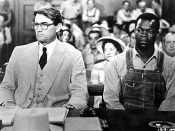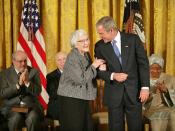To kill a Mockingbird, a novel by Harper Lee, communicates many themes concerning how its characters lose their innocence due to some form of moral corruption they were subjected to as children. At the beginning of To Kill a Mockingbird, Scout is an innocent, good-hearted five-year-old child who has no experience with the evils of the world. As the novel progresses, Scout has her first contact with evil in the form of racial prejudice. The basic development of her character is governed by the question of whether she will emerge from that contact with her conscience and optimism intact or whether she will be bruised or hurt. Scout learns that though humanity has a
great capacity for evil, it also has a great capacity for good. Though she is still a child at the end of the book, Scout's perspective on life develops from that of an innocent child into that of a near grown-up (Glasser 239).
Jem, Scout's brother, is her constant playmate at the beginning of the story. Four years older than Scout, he gradually separates himself from her games, but he remains her close companion and protector throughout the novel.
Jem moves into adolescence during the story, and his ideals are shaken badly by the eviland injustice that he perceives during the trial of Tom Robinson.
Another character, BooRadley, becomes the focus of the children's curiosity in the early chapters. As he fits the
perspective of childhood innocence, the outsider is given no identity apart from theyouthful superstitions that surround him: Scout describes him as a "malevolent phantom"
over six feet tall who eats squirrels and cats (Lee 13). Eventually, Boo will betransformed from a nightmare villain into a human being, and the children'sunderstanding of him will reflect their own journey toward adulthood. The appealingdepiction of childhood...



GREAT
this is a well set out essay with strong arguments and it is also interesting to read for any one who has or has not read the book, good job
4 out of 4 people found this comment useful.